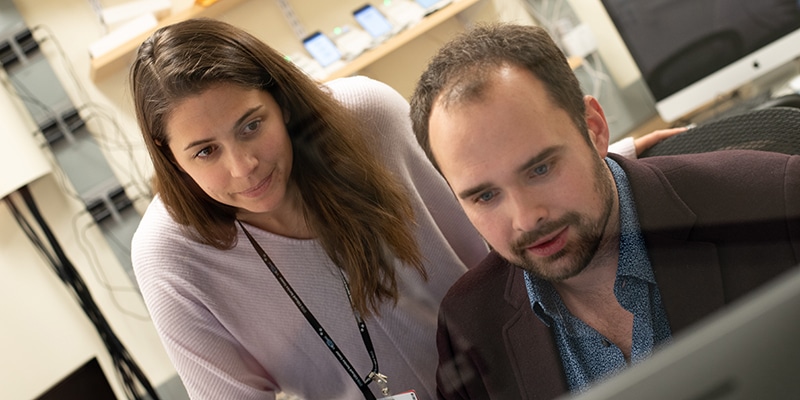Jan 17 2019
Depression and anxiety are shockingly common among young children—as many as one-in-five kids suffer from one of them, starting as early as the preschool years. But it can be difficult to spot these conditions, known as “internalizing disorders,” as the symptoms are so inward-facing that parents, teachers, and doctors frequently fail to see them.
 Ellen McGinnis and Ryan McGinnis of the University of Vermont, lead researchers on a study published in PLOS ONE that showed wearable sensors could detect hidden anxiety and depression in young children. (Photo: Josh Brown)
Ellen McGinnis and Ryan McGinnis of the University of Vermont, lead researchers on a study published in PLOS ONE that showed wearable sensors could detect hidden anxiety and depression in young children. (Photo: Josh Brown)
The issue is not inconsequential. Without treatment, children with internalizing disorders are at greater risk of suicide and substance abuse later in life.
“Because of the scale of the problem, this begs for a screening technology to identify kids early enough so they can be directed to the care they need,” says Ryan McGinnis, a biomedical engineer at the University of Vermont.
So McGinnis partnered with Ellen McGinnis, a clinical psychologist at the University of Vermont, and colleagues in the Department of Psychiatry at the University of Michigan, Maria Muzik, Katherine Rosenblum, and Kate Fitzgerald, to create a tool that could help monitor children for internalizing disorders, thereby catching them early enough to be treated. The research was published on January 16 in the journal PLOS ONE.
The team used a “mood induction task,” a standard research technique designed to stimulate particular behaviors and feelings such as anxiety. The scientists examined 63 children, some of whom were identified as having internalizing disorders.
Children were led into a faintly lit room, while the facilitator gave scripted statements to build eagerness, such as “Let’s be quiet so it doesn’t wake up” and “I have something to show you.” A covered terrarium was placed at the back of the room, which the facilitator quickly opened, and then pulled out a fake snake. The children were then reassured by the facilitator and permitted to play with the snake.
Generally, trained scientists would view a video of the task and score the child’s behavior and speech during the activity to diagnose internalizing disorders. In this research, the team used a wearable motion sensor to track a child’s movement, and a machine learning algorithm to examine their movement to differentiate between children with anxiety or depression and those without. After processing the movement data, the algorithm identified changes in the way the two groups moved that could be used to divide them, identifying children with internalizing disorders with 81% accuracy—better than the typical parent questionnaire.
The way that kids with internalizing disorders moved was different than those without.
Ryan McGinnis, biomedical engineer, University of Vermont
The algorithm established that movement during the first phase of the task, prior to the snake being revealed, was the most revealing of potential psychopathology. Children with internalizing disorders were inclined to turn away from the potential threat more than the control group. It also picked up on subtle differences in the way the children turned that helped differentiate between the two groups.
This matches well with what was anticipated from psychological theory, says Ellen McGinnis. Children with internalizing disorders would be expected to display more anticipatory anxiety, and the turning-away behavior is the sort of thing that human witnesses would code as a negative reaction when scoring the video. The benefit is that the sensors and algorithm work a lot faster.
“Something that we usually do with weeks of training and months of coding can be done in a few minutes of processing with these instruments,” she says. The algorithm required just 20 seconds of data from the anticipation phase to come to a decision.
That paves the way to using technology like this to help check large numbers of children to identify those that would gain from additional psychological help.
Children with anxiety disorders need an increased level of psychological care and intervention. Our paper suggests that this instrumented mood induction task can help us identify those kids and get them to the services they need.
Ellen McGinnis, Clinical Psychologist, University of Vermont
Not catching these disorders early can be an issue for kids as they grow up says Muzik. “If anxiety symptoms do not get detected early in life, they might develop into a full-blown anxiety and mood disorder,” she says, with successively increased risk for suicide and substance abuse.
If these conditions are detected early though, there are good treatments that can be availed, Muzik said. Early intervention is paramount as young children’s brains are very malleable and react well to treatment.
The following step will be to enhance the algorithm and develop extra tests to examine voice data and other information that will enable the technology to differentiate between anxiety and depression. The final goal is to design a battery of assessments that could be used in doctors’ offices or schools to screen children as part of their regular developmental assessments.
Muzik says developments such as this are stimulating because psychiatry has been falling behind other fields of medicine in its use of technology to assist diagnosis and treatment. “It’s exciting to move the field along with technology,” she says. “We are on the verge of new developments.”